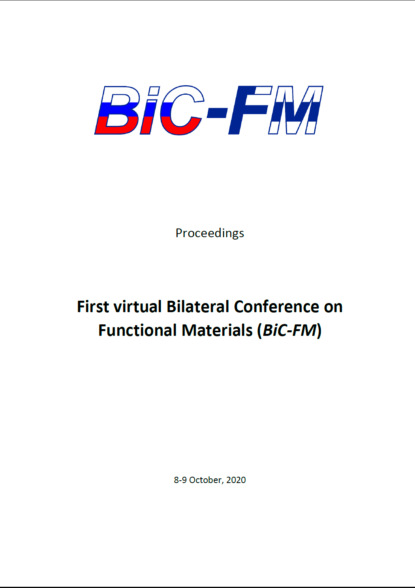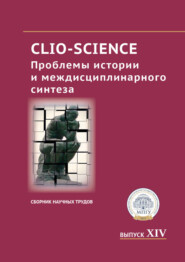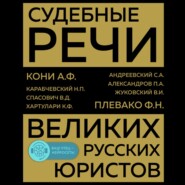По всем вопросам обращайтесь на: info@litportal.ru
(©) 2003-2024.
✖
First virtual Bilateral Conference on Functional Materials (BiC-FM)
Автор
Год написания книги
2020
Настройки чтения
Размер шрифта
Высота строк
Поля
2. Cao X., et al., Strain sensing behaviors of epoxy nanocomposites with carbon nanotubes under cyclic deformation. Polymer, 2017. 112: p. 1–9.
3. Kumar A., K. Sharma, and A.R. Dixit, Carbon nanotube- and graphene-reinforced multiphase polymeric composites: review on their properties and applications. Journal of Materials Science, 2019. 55(7): p. 2682–2724.
4. Camilli L. and Passacantando M., Advances on sensors based on carbon nanotubes. Chemosensors, 2018. 6(4): p. 62–80.
5. Atif R., I. Shyha, and F. Inam, Mechanical, thermal, and electrical properties of graphene-epoxy nanocomposites-A Review. Polymers, 2016. 8(8): p. 281–317.
6. Caradonna A., et al., Electrical and thermal conductivity of epoxy-carbon filler composites processed by calendaring. Materials (Basel), 2019. 12(9): p. 1–17.
Anisotropic electrical conductivity in graphene films with vertically aligned single-walled carbon nanotubes: new advances in mechanisms and applications
Glukhova O.E.
, Slepchenkov M.M.
1 – Saratov State University, Saratov, Russia
2 – I.M. Sechenov First Moscow State Medical University, Moscow, Russia
glukhovaoe@info.sgu.ru
In this paper, we suggest an idea of a new approach to control the electrical conductivity and its anisotropy in graphene-nanotube films with vertically oriented single-walled carbon nanotubes (SWCNTs) seamlessly connected to graphene. The basis of this approach is the phenomenon of aromaticity occurred in the hexagons of armchair-type SWCNTs at a certain nanotube length, which induces the oscillations of electronic characteristics with increasing the SWCNT length [1]. The proposed idea was tested on the example of two graphene nanomesh (GNM) atomistic models with nanoholes for SWCNTs with the chirality (6,6) and (9,9) in the case of sequentially increasing the SWCNT length. These types of SWCNTs were revealed using original approach called “virtual growing”, which shown that among the armchair SWCNTs with a diameter of 0.6–1.2 nm, the energetically favorable SWCNT- graphene junction will be formed with the SWCNTs (6,6) and (9,9). The calculations of geometric parameters of graphene-nanotube atomistic models were obtained using the self-consistent charge density functional tight-binding (SCC-DFTB) method [2]. The calculations of the electron transmission function T(E) and electrical conductivity G were carried out at 300 K using the Landauer-Buttiker formalism [3]. It was found that the nanoholes in monolayer graphene form conducting pathways in one direction, inducing anisotropy of the conducting properties. The anisotropy of the G value reaches 5 times. The formation of SWCNTs in the nanoholes does not remove anisotropy, amplifying it up to 7 times. The value of electrical conductivity G is strongly influenced by the length of the formed nanotube. It was found that a sharp increase in the value of G occurs at a certain length of 0.615 nm, 0.984 nm, 1.353 nm, and so on with in steps of 0.369 nm. These values of the SWCNT length were determined by the number of atomic layers in the SWCNT framework that is a multiple of three. Especially noticeable jumps in electrical conductivity occur for the armchair direction of electron transport. Thus, by adjusting the SWCNT length, it is possible to enhance or weaken the anisotropy of the conductive properties of graphene-nanotube films.
Acknowledgement. This work was supported by the Ministry of Science and Higher Education of the Russian Federation, grant FSRR-2020-0004.
References:
[1] F. Buonocore, F. Trani, D. Ninno, A. Di Matteo, G. Cantele, G. Iadonisi, Nanotechnology, 19, 025711 (2008).
[2] M. Elstner, D. Porezag, G. Jungnickel, J. Elsner, M. Haugk, Th. Frauenheim, S. Suhai, G. Seifert, Phys. Rev. B 58, 7260 (1998).
[3] S. Datta, Quantum Transport: Atom to Transistor. 2nd ed. Cambridge: Cambridge University Press; 2005
O.E. Glukhova received Ph.D. in Vacuum and Plasma Electronics (1997) and Dr. Sc. in Solid State Electronics and Nanoelectronics (2009) from the Saratov State University, Russia. She is a head of Department of Radiotechnique and electrodynamics at Saratov State University and leads the Division of Mathematical modeling in Educational and scientific institution of nanostructures and biosystems at Saratov State University. Her main fields of investigation are: nanoelectronics, molecular modeling of biomaterials and nanostructures, molecular electronics, mechanics of nanostructures, quantum chemistry and molecular dynamics, carbon nanostructures (fullerenes, nanotubes, graphene, graphane). She has published more 200 peer-reviewed journal papers and five monographs.
Oxygen evolution reaction on pristine and defective nitrogen-doped carbon nanotubes and graphene
Murdachaew G.
, and Laasonen K.
1) Aalto University, Department of Chemistry and Materials Science, Finland
kari.laasonen@aalto.fi
Hydrogen obtained by electrochemical water splitting on a suitable catalyst has raised a lot of interest. The ideal catalyst should be efficient, stable under operating conditions, and composed of earth-abundant elements. Density functional theory simulations within a simple thermodynamic model of the more difficult half-reaction, the anodic oxygen evolution reaction (OER), with a single-walled carbon nanotube as a catalyst, showed that the presence of < 1 % nitrogen reduces the required OER overpotential significantly. We performed an extensive exploration of systems and active sites with various nitrogen functionalities [1] (graphitic, pyridinic, or pyrrolic) obtained by introducing nitrogen and simple lattice defects (atomic substitutions, vacancies, or Stone-Wales rotations). The lowest predicted overpotentials were about 0.4 V, close to what has been measured experimentally for the best-performing nitrogen-doped nanocarbon catalysts. The lowest predicted overpotential of 0.39 V was obtained for a model system with a Stone-Wales defect in combination with pyrrolic nitrogen doping. The most OER-active sites/systems were carbon atoms in the vicinity of Stone-Wales pyrrolic nitrogen, followed by graphitic nitrogen. For the majority of the nanotube-based systems, the third step of the four-step OER mechanism, the formation of attached OOH, is the potential-determining step of the reaction. The nanotube radius and chirality effects were examined by considering OER in the limit of large radius by studying graphene as a model system. They exhibited trends similar to those of the nanotube-based systems but often with reduced reactivity due to weaker attachment of the OER intermediate molecules.
References:
[1] G. Murdachaew and K. Laasonen J. Phys. Chem. C, 2018, 122, 25882, https://doi.org/10.1021/acs.jpcc.8b08519
Kari Laasonen is a professor of physical chemistry in Aalto University (from 2010). He did his M.Sc. in University of Helsinki 1988, PhD. in 1991 in TKK (physics). Before Aalto he worked in EPFL (Lausanne), IBM Research Laboratory (Zurich), University of Pennsylvania (Philadelphia) and University of Oulu. He has specialized to computational chemistry and especially on modelling surfaces and electrochemical reactions. He has also long expertise of modelling reaction in solutions. He has published more 150 papers and these papers have been cited more than 10.000 times.
Starfish-like phosphorus carbide nanotubes
Kistanov A. A.
, Shcherbinin S. A.
, Huttula M.
, Cao W.
1 – Nano and Molecular Systems Research Unit, University of Oulu, Oulu, Finland
2 – Southern Federal University, Rostov-on-Don, Russia
stefanshcherbinin@gmail.com
Recently several allotropes of a novel two-dimensional material, phosphorus carbide (PC), have been predicted theoretically and some of them have already been successfully fabricated [1]. For one of these PC allotropes, α-PC, the possibility of its rolling to a PC nanotube (PCNT) at room temperature under compressive strain has been found [2]. These PCNTs of different sizes exhibit high thermal stability and possess well tunable band gap. In this work, PCNT obtained by the rippling of β
-PC and β
-PC monolayers along their armchair (APCNT) and zigzag (ZPCNT) directions are investigated in the framework of density functional theory.
It has been found that most of created β-PCNTs possess starfish-like structure (see Figure 1a). The dynamical stability of these β-PCNTs has been verified using ab initio molecular dynamics calculations conducted at 300 K. It is also found that β-PCNTs of the smallest/biggest size consist of 12/44 atoms. According to electronic band structure calculations, β-PCNTs can be semiconductors, semimetals or metals depending on their size and form (see Figure 1b). Therefore, due to their extraordinary form and highly tunable band structure, β-PCNTs may find the application in straintronic, optical and photovoltaic devices.
Figure 1. (a) Atomic structure and (b) band gap size as a function of size of β
– and β
-APCNT and β
– and β
-ZPCNT.
Acknowledgement.A.A.K. M.H. and W.C. acknowledges the financial support by the Academy of Finland (grant No. 311934). S.A.Sh. acknowledges the financial support by the Ministry of Education and Science of the Russian Federation (state task in the field of scientific activity, Southern Federal University), theme N BAS0110/20-3-08IF.
References:
[1] X. Huang, Y. Cai, X. Feng, W. C. Tan, D. Md. N. Hasan, L. Chen, N. Chen, L. Wang, L. Huang, T. J. Duffin, C. A. Nijhuis, Y. W. Zhang, C. Lee and K. W. Ang, ACS Photonics, 5(8), 3116–3123 (2018)
[2] S. A. Shcherbinin, K. Zhou, S. V. Dmitriev, E. A. Korznikova, A. R. Davletshin and A. A. Kistanov, J. Phys. Chem. C, 124(18), 10235-10243 (2020)
Computational search for new high-T
superconductors with subsequent synthesis












